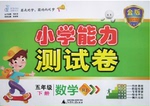题目内容
1.-Someone wants you on the phone.- nobody knows I am here.( )
| A. | Although | B. | And | C. | But | D. | So |
分析 --有人打电话找你.--但是没有人知道我在这儿.
解答 答案:C A项"虽然,尽管",引导让步状语从句;B项"和,并且",并列连词,连接并列句,表示顺承关系;C"但是",转折连词,表示转折;D"因此",因果连词,表示原因.因为此句是简单句,所以排除A项.通过"nobody knows I am here"可知,此处是转折.排除B、D两项.故选C项.
点评 考查并列连词.主要看每个并列连词的功能,然后再根据句意做出选择.

练习册系列答案
 期末100分闯关海淀考王系列答案
期末100分闯关海淀考王系列答案 小学能力测试卷系列答案
小学能力测试卷系列答案
相关题目
4.Part of the reason Charles Dickens loved his own novel,David Copperfield,was__ it was rather closely modeled on his own life.( )
| A. | what | B. | that | C. | why | D. | whether |
12.Had she ___________ her promise,she would have made it to Yale University.( )
| A. | looked up to | B. | lived up to | C. | kept up with | D. | come up with |
9.-What a mistake!
-Yes.I his doing it another way,but without success.( )
-Yes.I his doing it another way,but without success.( )
| A. | was suggesting | B. | will suggest | C. | would suggest | D. | had suggested |
16.John went to the hospital alone.
If he me about it,I would have gone with him.( )
If he me about it,I would have gone with him.( )
| A. | should tell | B. | tells | C. | told | D. | had told |
6.The door _____ open,no matter how hard she pushed.( )
| A. | shouldn't | B. | couldn't | C. | wouldn't | D. | mightn't |
13.A serious study of physics is impossible some knowledge of mathematics.( )
| A. | against | B. | before | C. | beyond | D. | without |
10.society( )
| A. | official | B. | recent | C. | chocolate | D. | difficult |